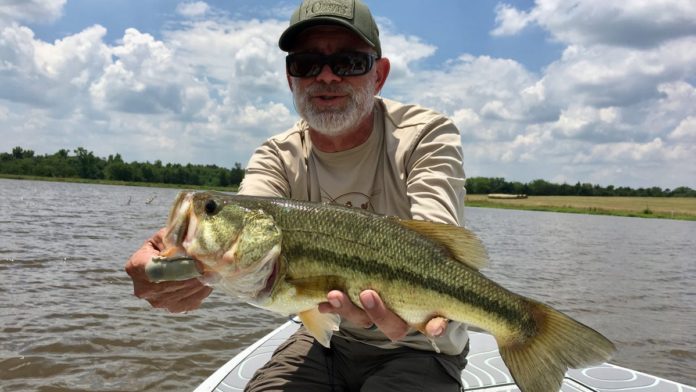Don’t look now, but the hottest weather of summer may soon be gripping North and East Texas this next week.
But even so, given reasonable water temps for this time of year, there can still be some fair bass fishing action to be found on the fly as the 2021 version of Independence Day fades into the rearview mirror.
Even on a big water body like Lake Fork, an East Texas reservoir that can fish surprisingly good during the summer months according to Rob Woodruff, my longtime friend and an Orvis endorsed fly fishing guide who spent years on the lake before moving to trout country.
The key is knowing where to look…and when.
“If you’re going to fish Fork in the summertime, you’ve got to target the creek channels, particularly the bends in the creek channels, and humps and roadbeds,” said Woodruff, a Texas A&M educated entomologist.
“But the thing that a lot of people overlook is that there still are fish up in the shallow water around weedlines or shady areas with access to deeper water. That’s especially true early and late in the day.”
Which is why Woodruff recommends that fly anglers learn to target the shady spots of summertime: “Fishing east-side, west-facing banks in the morning along the shadeline and vice versa in the afternoon can produce some good fish. Timber helps – if it is a timbered shoreline, you’ve got a longer shadeline to fish.”
In Woodruff’s experience, early is often better than late during the summer months.
“I’ll have the boat running and on the water before the sun is up,” he said. “I try to be out there early and work those shallows and weedlines with a topwater. Then I’ll drop back as the sun rises and move to deeper points. I usually get off of there about lunchtime.”
When targeting Fork’s summertime bass, Woodruff uses heavy back-boned seven, eight, and nine-weight Orvis Helios III fly rods coupled with saltwater style fly reels to get the job done
To his fly line — either an Orvis Hydros Bass floating line; an Orvis Hydros HD Bank Shot sink-tip line; or an Orvis Hydros HD Depth Charge full sinking line — he will use his own hand-tied leaders.
Those leaders consist of a 40-pound butt section of Ande Billfish line in the Envy Green color or Stren High Impact in the Low-Vis gray color. The rest of his seven and a half to eight foot leader will consist of sections of 30-pound and 20-pound monofilament tipped with 12 to 14 pound tippet material.
Tied to the end of those leaders, Woodruff’s summertime fly box will include his own creations, the Lake Fork Leech; the Swamp Rabbit; Rob’s Keel Shad; the Dizzy Dean and the SiLLI Shad. All will work on deep-water bass, especially the Swamp Rabbit (similar to a jig-and-pig conventional lure) which I used a few years back to land a summertime lunker that was nearly seven pounds in weight.
In addition, Woodruff’s fly selection will often include a Rob’s Patassa; a swimming frog pattern; 1/0 topwater poppers from Orvis; 2/0 Double Barrel poppers from Flymen Fishing Company; Dahlberg Rabbit Strip divers; Whitlock’s Leadeye Leech; Lefty’s Deceivers; and of course, plenty of Clouser Minnows.
As important as the right fly selection is, the Arkansas based guide and commercial fly tier believes that fly design is even more critical for success.
Woodruff, who has himself pulled an 11.75-pound lunker bass from Fork on the fly rod, relies on flies that offer a slow fall, neutral buoyancy and a tantalizing motion.
When a fly has those qualities, it is often more than a big bass can handle as the fly is slowly pulled by.
Even during the sizzling days of summertime spent on a bass water deep in the heart of East Texas.
Credit: Source link





























